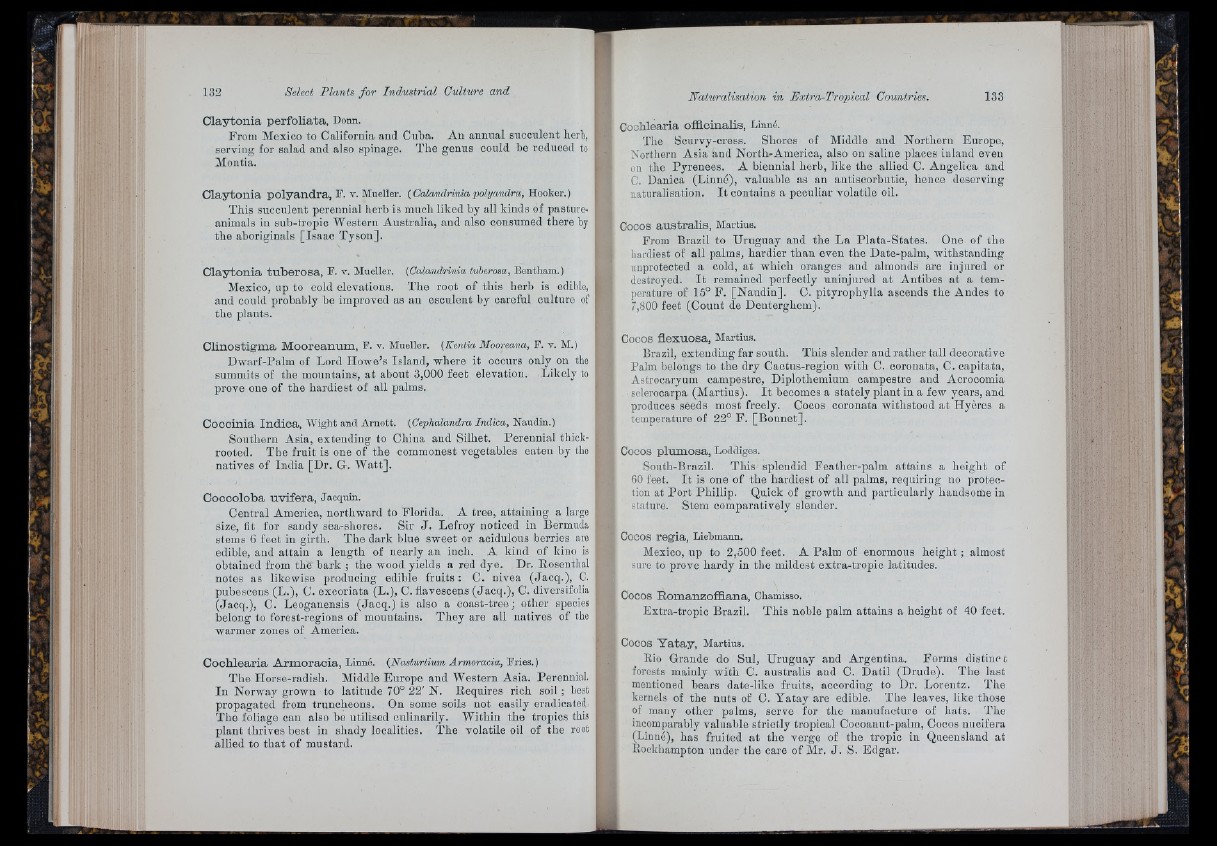
r
C la y to n i a p e r fo l i a t a , Donn.
From Mexico to California and Cuba. An annual succulent herb,
serving for salad and also spinage. The genus could be reduced to
Montia.
C l a y to n i a p o ly a n d r a , F. V. Mueller. (Calandrinia polyandra. Hooker.)
This succulent perennial herb is much liked by ail kinds of pasture-
animals iu sub-tropic Western Australia, and also consumed there ’
the aboriginals flsaao Tyson].
C la y to n i a tu b e r o s a , F. v. Mueller. [Calandrinia tuberosa, Bentham.)
Mexico, up to cold elevations. The root of this herb is edible,
and could probably be improved as an esculent by careful oulturo of
the plants.
C lin o s tigm a M o o r e a n um , F. v. Mueller. {Kentia Mooreana, P. v. M.)
Dwarf-Palm of Lord Howe’s Island, where it occurs only on the
summits of the mountains, a t about 3,000 feet elevation. Likely to
prove one of the hardiest of all palms.
C o o c in ia In d ic a , Wight and Arnott. (Cephalandra Indica, Naudin.)
Southern Asia, extending to China aud Silhet. Perennial thick-
rooted. The fruit is one of the commonest vegetables eaten by the
natives of India [Dr. G. Wa tt].
C o c o o lo b a u v if e r a , Jaequin.
Central America, northward to Florida. A tree, attaining a large
size, fit for sandy sea-shores. Sir J . Lefroy noticed in Bermuda
stems 6 feet in girth. The dark blue sweet or acidulous berries are
edible, aud attain a length of nearly an inch. A kind of kino is
obtained from the bark ; the wood yields a red dye. Dr. Rosenthal
notes as likewise producing edible fruits : C. nivea (Jacq.), C.
pubescens (L.), G. excoriata (L.), C. flavescens (Jacq.), C. diversifolia
(Jacq.), C. Leoganensis (Jacq.) is also a coast-tree ; other species
belong to forest-regions of mountains. They are all natives of the
warmer zones of America.
C o o b le a r ia A rm o r a c i a , Linné. (Nasturtium Armoracia, Fries.)
The Horse-radish. Middle Europe and Western Asia. Perennial.
In Norway grown to latitude 70° 22' N. Requires rich soil ; best
propagated from truncheons. On some soils not easily eradicated
'The foliage can also be utilised oulinarily. Within the tropics this
plant thrives best in shady localities. 'The volatile oil of the root
allied to th a t of mustard.
C o o blearia o ffic in a lis , Linné.
The Sourvy-cress. Shores of Middle and Northern Europe,
Northern Asia and North-America, also on saline places inland even
on the Pyrenees. A biennial herb, like the allied C. Angelica and
C. Danica (Linné), valuable as an antiscorbutic, hence deserving
naturalisation. I t contains a peculiar volatile oil.
Cocos a u s tra lis , Martins.
From Brazil to Uruguay aud the La Plata-States. One of the
hardiest of all palms, hardier than even the Date-palm, withstanding
unprotected a cold, at which oranges and almonds are injured or
destroyed. I t remained perfectly uninjured a t Antibes a t a temperature
of 15° F. [Naudin]. C. pityropliylla ascends tlie Andes to
"7,800 feet (Count de Denterghem).
Cocos flex u o sa, Martius.
Brazil, extending far south. This slender and rather tall decorative
Î -j] Palm belongs to the dry Cactus-region with C. coronata, C. capitata,
Astrooaryum campestre, Diplothemlum campestre aud Acrocomia
sclerocarpa (Martius). I t becomes a stately plant in a few years, and
produces seeds most freely. Cocos coronata withstood a t Hyères a
temperature of 22° F. [Bonnet].
Cocos p lum o sa , Loddiges.
South-Brazil. 'This splendid Feather-palm attains a height of
60 feet. I t is one of the hardiest of all palms, requiring no protection
at Port Phillip. Quick of growth and particularly handsome in
stature. Stem comparatively slender.
Cocos regia, Liebmann.
Mexico, up to 2,500 feet. A Palm of enormous height ; almost
sure to prove hardy in the mildest extra-tropio latitudes.
Cocos Roman zo fflan a , Chamisso.
Extra-tropic Brazil. This noble palm attains a height of 40 feet.
Cocos Y a ta y , Martins.
Rio Grande do Sul, Uruguay and Argentina. F orms distino t
forests mainly with C. australis and C. Datil (Drude). The last
mentioned bears date-like fruits, according to Dr. Lorentz. 'The
kernels of the nuts of C. Yatay are edible. The leaves, like those
of many other palms, serve for the manufacture of hats. The
incomparably valuable strictly tropical Cocoauut-palm, Cocos nucífera
(Linné), has fruited a t the verge of the tropic in Queensland at
Rockhampton under the care of Mr. J . S. Edgar.